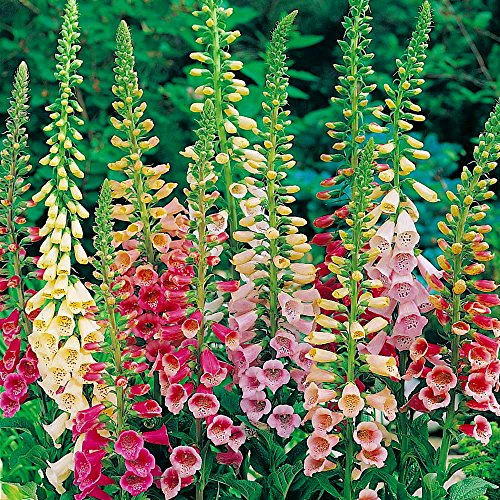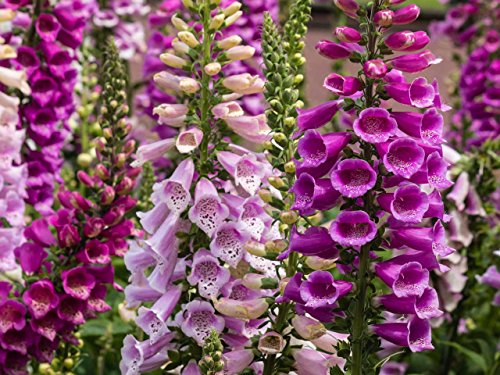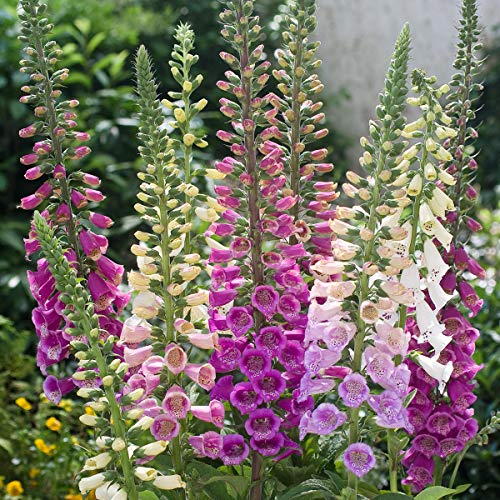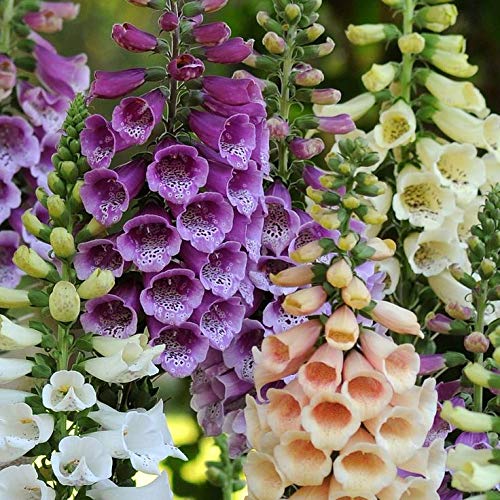This post contains affiliate links. If you buy something from one of our links we may earn a commission. Thanks
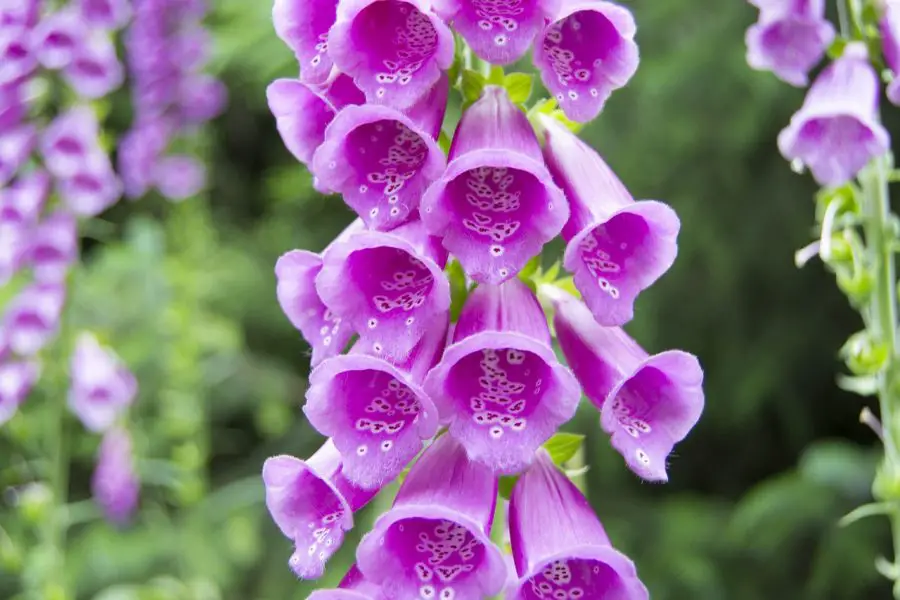
Unleash your green thumb by Growing Foxgloves in Pots. Our guide is chock-full of tips for nurturing these stunning blooms, all in a cozy space of your own. Give it a try!
Growing Foxgloves in pots requires well-drained, rich soil and partial to full shade. Use a pot that is at least 12 inches in diameter and has drainage holes. Water when the soil’s top inch is dry, and feed with a balanced fertilizer every 4-6 weeks during the growing season.
Ever considered brightening up your patio or balcony with some tall, elegant blooms?
Look no further, as growing Foxgloves in pots is the perfect way to add a dash of charm to any small space.
Imagine stepping out each morning to vibrant colors dancing in the breeze, all from a simple pot!
Foxgloves not only bring a unique beauty, but they’re also quite the conversation starters.
So, let’s delve into how to bring this delightful vision to life, shall we?
An Introduction To Growing Foxgloves in Pots
Welcome, budding gardeners and seasoned green thumbs alike! Today, we’re diving into the enchanting world of Growing Foxgloves in Pots.
Why Foxgloves, you ask? Well, with their towering stalks of bell-shaped flowers and vibrant hues, they’re just the thing to turn any balcony or patio into a mini-garden haven.
And don’t worry if you’re new to the gardening scene, or have only a cozy corner for your plant buddies.
In this post, we’ll navigate everything from picking the right Foxglove variety for your pot, to sowing seeds, right through to ongoing care tips.
Ready to embark on this colorful journey? Let’s get our hands dirty!
Unveiling the Foxglove: A Glimpse Into Their Allure
Let’s begin with a little introduction to our plant of interest the Foxglove, also known as the common Foxglove or digitalis purpurea.
These fascinating characters, with their tall stalks punctuated by a cascade of bell-shaped blooms, never fail to turn heads.
Their blossoms range from soft purples and pinks to striking whites, a palette designed to woo both gardeners and pollinators alike.
They’re more than just a pretty face, though. Foxgloves play a crucial role in our medical world too, as their leaves are the primary source of the heart medicine, digoxin.
Isn’t it amazing that such beauty can pack such a punch?
The Joy of Potting: Why Foxgloves Love Containers
You might wonder, why should I consider growing Foxgloves in pots?
Well, for starters, container gardening offers the ultimate flexibility.
You can move your plants around to catch the sunlight, protect them from harsh weather, or simply redecorate your outdoor space.
Foxgloves, in particular, adapt beautifully to life in pots, adding height and color without needing a lot of horizontal space.
Plus, pots make it easier to manage soil quality and moisture, ensuring your Foxgloves have the ideal conditions to thrive in.
Now, that’s what we call a win-win!
Blooming Marvels: The Aesthetic Splendor of Foxgloves
Let’s take a moment to imagine the charm that Foxgloves can bring to your little garden nook.
Picture their towering stems swaying gently in the breeze, each bell-shaped flower like a delicate brushstroke of color against the sky.
In the morning, they capture dewdrops in their blossoms; by twilight, they stand as silent sentinels, their forms etched against the fading light.
Whether you’re sipping your morning coffee or unwinding after a long day, the sight of these floral beauties can truly elevate your garden experience.
And that, dear readers, is the aesthetic magic of growing Foxgloves in pots.
What are Foxgloves?
Well, now that we’ve whetted your appetite, let’s dive a little deeper, shall we?
Foxgloves, those charming starlets of many a garden scene, are plants that have earned their popularity.
But what exactly are they? What sets them apart from the other pretty faces in the floral lineup?
According to Wikipedia: Digitalis is native to Europe, western Asia, and northwestern Africa. The flowers are tubular in shape, produced on a tall spike, and vary in colour with species, from purple to pink, white, and yellow.
The best-known species is the common foxglove, Digitalis purpurea. This biennial is often grown as an ornamental plant due to its vivid flowers which range in colour from various purple tints through pink and purely white. The flowers can also possess various marks and spottings. Other garden-worthy species include D. ferruginea, D. grandiflora, D. lutea, and D. parviflora.
Grab your gardening gloves, my friends, as we’re about to delve into the captivating world of Foxgloves and learn why they might just be the next star addition to your personal container garden!
Foxgloves Up Close: A Garden Star Revealed
Let’s get a closer look at our blooming beauties.
Foxgloves, with their scientific name Digitalis purpurea, are perennials that steal the show with their stately flower spikes.
They boast rows of bell-shaped blossoms, each with unique patterns and spots inside, adding to their charm.
Their leaves are an appealing bright green, rosette-shaped, and emit a somewhat intoxicating fragrance.
All in all, their distinctive look and form make them an undeniable highlight in any garden setting.
Seasons of Change: Understanding the Foxglove Lifecycle
Now, let’s talk about Foxglove’s lifecycle. Foxgloves are biennials, which means they have a two-year growing cycle.
In the first year, they focus on building up their energy, growing lush foliage but typically not flowering.
It’s in the following year that the magic happens. This is when they shoot up their tall flower stalks and show off their stunning blooms.
Once they’ve finished flowering, they drop seeds that will grow into new Foxglove plants, continuing the cycle.
Understanding this lifecycle is key to knowing when and how to plant your Foxgloves.
A Rainbow of Blooms: Foxglove Colors and Varieties
If you’re looking for variety, Foxgloves have got you covered. These gorgeous plants come in a range of colors, from classic purples and pinks to crisp whites and even yellows.
Some varieties have a single color, while others display a gradient of hues. For instance, the ‘Alba’ variety is known for its pure white flowers, creating a cool, serene aesthetic.
On the other hand, ‘Pam’s Choice’ Foxgloves show off white blooms with deep purple throats, making a dramatic and eye-catching statement.
Each variety has its own charm, adding different layers of beauty to your garden. So, why not try a mix for a vibrant, colorful display?
Why Grow Foxgloves in Pots?
Alright, you’ve gotten to know the Foxgloves a little better. You’ve seen their wide variety of colors and learned about their fascinating two-year life cycle.
But you may be wondering, ‘Why should I grow Foxgloves in pots? What’s the advantage?’
Well, hold onto your trowel, my fellow garden enthusiasts, as we dive into the numerous reasons why these fantastic flowers are an ideal choice for pot cultivation.
From versatility to simplicity, we’re about to explore all the amazing benefits of growing Foxgloves in pots. Let’s get started!
Pot Perks: The Benefits of Growing Foxgloves in Pots
Who doesn’t love the idea of having portable beauty at their fingertips?
One of the main perks of growing Foxgloves in pots is the flexibility it offers.
If your Foxgloves are tucked away in a pot, you can easily move them around to create new aesthetics or cater to their sunlight needs.
Plus, if you’re dealing with a smaller garden or a balcony, pots allow you to maximize your space.
You can grow new plants right there in a large container and create your very own Foxglove oasis, even if you’re working with limited space.
Small Space, Big Impact: Foxgloves in Tight Quarters
In case you were wondering, yes, Foxgloves are incredibly versatile plants.
They’re a fantastic choice for small spaces and woodland gardens, bringing a touch of wild beauty wherever they’re planted.
You can squeeze them into corners, place them on the edge of pathways, or even use them to add height to a balcony garden.
And the best part? They’re more than happy in dappled part shade, which is often what small or woodland gardens offer.
Foxgloves: Nature’s Magnet
What could be more wonderful than a garden buzzing with life?
Foxgloves are not only beautiful, but they’re also a magnet for wildlife, attracting a host of pollinators like bees and hummingbirds.
Planting Foxgloves in pots near your windows or seating areas will give you a front-row seat to nature’s show, as you watch these charming visitors enjoy the nectar-rich flowers.
And hey, it’s not just about the aesthetic! By attracting pollinators, you’re also playing a part in supporting local biodiversity.
Now, how cool is that?
Choosing the Right Foxglove for Your Pot
Let’s level up our Foxglove game now! You’ve decided you’re growing Foxgloves in pots – great choice!
Now, which variety should you opt for? With a palette of purples, pinks, yellows, and whites, along with their varying sizes, choosing the right Foxglove might seem like a daunting task.
We are here to guide you through the flower-strewn labyrinth. In this section, we’ll be exploring the different types of Foxgloves suitable for pot culture, ensuring you make the perfect choice for your unique garden space.
Are you ready? Let’s dive in!
Picking the Perfect Pot Foxgloves: Selecting the Best Types for Container Displays
Navigating through the world of Foxgloves might feel a bit like going down a rabbit hole.
There are so many beautiful varieties! For containers, you might consider Digitalis grandiflora, also known as yellow Foxglove.
It’s a hardy perennial species that thrives in pots and flaunts pale yellow, bell-shaped flowers.
On the other hand, Digitalis lutea, or the straw Foxglove, is a charm with its slender spikes and delicate, smaller yellow blooms.
Remember, the choice of Foxglove depends on your aesthetic preferences and the specific conditions of your garden or patio.
Timely Tips: Choosing the Best Time and Place for Planting
Just as important as selecting your Foxglove is deciding when and where to plant it.
As a general rule of thumb, early spring is an excellent time to sow Foxglove seeds or plant young Foxgloves in pots.
This gives them plenty of time to establish before the growing season kicks in.
As for location, Foxgloves prefer full sun to partial shade. Remember, in hotter climates, they appreciate a little more shade, especially during the scorching afternoon sun.
Position your pots accordingly to keep your Foxgloves happy.
Classic Vs. Modern: The Common Foxglove and New Hybrids
The common Foxglove, Digitalis purpurea, has been a cottage garden favorite for centuries.
Its tall spires of bell-shaped purple flowers have a traditional, almost fairy-tale charm.
But if you’re feeling adventurous and fancy something different, you might consider some of the new hybrids on the block.
These modern varieties offer an expanded color palette, including some breathtaking bicolored and speckled varieties.
Remember, whether you go for the old favorites or try something new, all Foxgloves carry a distinct elegance that will certainly grace your garden.
How to Grow Foxgloves in Pots
Looking forward to trying your hand at growing Foxgloves in pots but unsure where to start?
Don’t worry, this journey is going to be fun, educational, and ultimately rewarding.
Whether you’re a seasoned gardener or a newcomer to the plant world, you’ll find Foxgloves surprisingly easy to handle.
Let’s dive right into the simple steps you’ll need to follow to cultivate these beautiful blooms right on your patio or balcony.
Get ready for a potful of charm, color, and hummingbird attractions!
Starting Your Foxglove Journey: Planting the Seeds
Growing Foxgloves in pots begins with sowing the seeds, ideally during the early summer.
Foxglove requires good drainage. Opt for a potting mix composed of coco coir and perlite, a pairing that ensures your seeds have the best possible growing environment.
Perlite is a fantastic ingredient to improve drainage, while coco coir retains water, providing the perfect balance.
Place your Foxglove seeds on top of the soil, and gently press them in, but don’t bury them – they need light to germinate.
Let Your Foxgloves Breathe: Ensuring Good Air Circulation
Once your seeds are nestled in their new home, it’s crucial to focus on maintaining the soil surface.
Avoid packing the soil too tightly – your Foxgloves appreciate a little breathing room.
Good air circulation is key, and it helps to keep fungal diseases at bay.
Feeding Your Foxgloves: The Importance of Rich Soil and Organic Matter
Foxgloves flourish in rich soil, teeming with organic matter. When preparing your potting mix, consider adding a little compost or well-rotted manure.
This not only provides essential nutrients but also enhances the soil’s texture and moisture-holding capacity, ensuring your Foxgloves have the best nourishment to grow strong and healthy.
Just Right: Watering Your Foxgloves
Getting the watering right is vital when growing Foxgloves in pots.
These beauties like their soil to be consistently moist but never soggy.
Overwatering can lead to root rot and other moisture-related issues.
A good rule of thumb is to water deeply but less frequently, allowing the soil to dry out slightly between waterings.
In the Right Light: Providing Ideal Lighting Conditions for Your Foxgloves
Lastly, let’s talk about lighting. While Foxgloves can handle a bit of shade, they truly thrive in full sun to partial shade.
If you’re growing Foxgloves in pots, this gives you a great advantage – you can move them around to catch the best rays!
Keep an eye on your plants and adjust their spot to keep them in the light they love.
Foxglove Care Tips
Who doesn’t love a thriving, blooming pot of Foxgloves?
Maintaining their splendid looks and health involves a bit of TLC, but nothing a devoted gardener can’t handle.
In this section, we’ll be diving into some valuable Foxglove care tips to help you on this blooming journey.
From how to prune, fertilize, and protect these beauties from pests and diseases to how to prepare them for the colder months, we’ll walk you through it all.
Your Foxgloves will thank you with stunning blooms and robust growth, becoming the star of your garden or balcony. Let’s get to it, shall we?
Proper Care of Your Foxgloves
When it comes to taking care of your Foxgloves, simplicity is key. Despite their grandeur, these beauties don’t demand much.
But remember, while tending to your plants, always wear gloves as all parts of the Foxglove plant are toxic if ingested.
A little care goes a long way, and with regular watering and occasional fertilizing, your Foxgloves will flourish beautifully.
Facing the Foe: Dealing with Diseases and Pests
Foxgloves can sometimes encounter a few unwanted guests or succumb to diseases.
The most common culprits are powdery mildew, a fungal disease that leaves a white coating on the leaves, and pests like Japanese beetles and spider mites.
A regular check on your plants, a good organic insecticidal soap or some neem oil, and ensuring good air circulation can go a long way in keeping these issues at bay.
Winter is Coming: Preparing Foxgloves for Cold Weather
For those in regions with cold winters, preparing your Foxgloves for the chill is crucial.
Despite being hardy, they need some help to brave the freezing temperatures.
Keep your pots in a sheltered area, ensuring they receive at least an inch of rain or equivalent watering every week.
Mulching can also help in protecting the base of the plant.
Keep the Blooms Coming: The Importance of Deadheading
Who doesn’t want a pot full of vibrant Foxglove flowers all summer?
Deadheading, or removing spent flowers, is the secret to this! Not only does it keep your plant looking neat, but it also encourages the growth of more flower spikes.
So, keep those pruners handy and give your Foxgloves a little trim when they start to fade, your efforts will be rewarded with a bloom-filled summer!
Foxglove In Pots FAQ
In your gardening adventure with Foxgloves, you might find yourself with a few queries. And you’re not alone.
That’s why we’ve gathered some of the most frequently asked questions about growing Foxgloves in pots, and we’re tackling them head-on.
From inquiries about how often to water, to what to do when your Foxgloves finish blooming, we’re here to shine a light on those garden curiosities.
So, let’s dive in and answer those burning questions, shall we?
Q: How do you care for potted Foxglove?
A: Caring for a potted Foxglove is quite simple. Ensure you water it adequately, usually when the top inch of soil is dry.
Maintain good air circulation around the plant and ensure it gets partial to full sunlight.
Also, be vigilant about pests and diseases, and deadhead spent blooms to promote more flowering.
Q: How many times a year do Foxgloves bloom?
A: Foxgloves typically bloom once a year.
They are biennial plants, so the first year is dedicated to growing the leafy rosette, and the blooms burst forth in the second year, usually in the early to mid-summer.
Q: Does Foxglove like sun or shade?
A: Foxgloves can tolerate a range of light conditions but generally prefer partial shade.
However, in cooler climates, they can handle more sun. The key is to keep their roots cool and shaded.
Q: How do you keep Foxgloves blooming all summer?
A: Deadheading or removing the spent flower spikes will help keep your Foxgloves blooming all summer.
This prevents the plant from putting energy into seed production and encourages it to produce more blooms.
Q: Do Foxgloves bloom more than once a summer?
A: Typically, Foxgloves bloom once per summer.
However, if you deadhead the spent blooms, some varieties might produce a second, smaller flush of flowers in the same season.
Q: What should you do with Foxgloves when they have finished flowering?
A: Once Foxgloves have finished flowering, you should cut back the flower spikes close to the base.
Leave the foliage as it will help gather energy for the next blooming season.
If it’s a biennial variety, it will self-seed around the garden for future generations of flowers.
Q: Are Foxgloves poisonous?
A: Yes, all parts of the Foxglove plant are poisonous if ingested, both for humans and pets.
The plant contains cardiac glycosides, which can cause heart problems, nausea, and even death in severe cases.
Always handle with care, particularly around children and pets.
Growing Foxgloves in Pots Final Thoughts
Alright, let’s wrap up our Foxglove journey! Who knew that this simple, elegant plant could offer such an array of insights and surprises?
As we draw this guide to a close, let’s take a moment to bask in the knowledge we’ve gleaned about growing Foxgloves in pots.
We’ve explored the beauty of Foxgloves, the benefits they bring to our homes and gardens, and the practical steps to cultivate them successfully.
I hope you’ve enjoyed the journey as much as I have, and you’re feeling ready to introduce these gorgeous plants into your own little corner of nature.
Let’s take all these valuable tips and bloom with our Foxgloves!
Giving Foxgloves a Chance
Hey, why not give it a shot? Growing Foxgloves in pots might seem daunting at first, but as we’ve seen throughout this guide, it’s a task well within our reach.
From choosing the right pot to selecting your favorite variety of Foxglove, it’s a rewarding journey, and I’m pretty sure you’d enjoy it!
So go ahead, and let those green thumbs work their magic!
The Enchanting World of Foxgloves
We’ve talked a lot about the ins and outs of growing these plants, but let’s not forget why we fell in love with Foxgloves in the first place.
Their towering stalks adorned with bell-like flowers bring an unmistakable charm to any space.
And with all the benefits they offer from beautifying your home to attracting delightful pollinators, it’s clear that Foxgloves are not just pretty faces, but all-rounders in the world of plants!
Read more: Backyard Gardening Ideas – Easy Garden Ideas For Beginners



